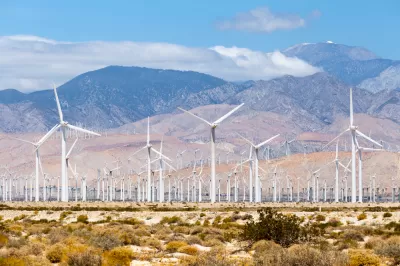Renewable energy, both wind and solar, takes up a lot of space in places that aren't accustomed to industrial development. Policymakers need strategies and tactics for overcoming the inherent land use challenges presented by renewable energy.

Samantha Gross writes about the land use complications with renewable energy generation and transmission, and the local opposition that arises as a result. Unfortunately, writes Gross, "[the] inherent attributes of wind and solar generation make conflicts over land use and project siting more likely."
Gross lists more than just a few of those inherent attributes. But there's also reason for hope that some of those inherent attributes and the resulting local opposition can be overcome:
Offshore wind eliminates land use, but it raises opposition among those concerned with the impact on the environment and scenic views. Building on previously disturbed land and combining renewable power with other land uses, like agriculture or building solar on rooftops, can minimize land use conflicts. Community involvement in project planning and regulations for land use and zoning can help to alleviate concerns.
The text sampled here is pulled from the executive summary of a longer report, published this month [pdf], intended to help policymakers overcome land use obstacles standing in the way of a lower-carbon energy system.
FULL STORY: Renewables, land use, and local opposition in the United States

Alabama: Trump Terminates Settlements for Black Communities Harmed By Raw Sewage
Trump deemed the landmark civil rights agreement “illegal DEI and environmental justice policy.”

Planetizen Federal Action Tracker
A weekly monitor of how Trump’s orders and actions are impacting planners and planning in America.

Why Should We Subsidize Public Transportation?
Many public transit agencies face financial stress due to rising costs, declining fare revenue, and declining subsidies. Transit advocates must provide a strong business case for increasing public transit funding.

Understanding Road Diets
An explainer from Momentum highlights the advantages of reducing vehicle lanes in favor of more bike, transit, and pedestrian infrastructure.

New California Law Regulates Warehouse Pollution
A new law tightens building and emissions regulations for large distribution warehouses to mitigate air pollution and traffic in surrounding communities.

Phoenix Announces Opening Date for Light Rail Extension
The South Central extension will connect South Phoenix to downtown and other major hubs starting on June 7.
Urban Design for Planners 1: Software Tools
This six-course series explores essential urban design concepts using open source software and equips planners with the tools they need to participate fully in the urban design process.
Planning for Universal Design
Learn the tools for implementing Universal Design in planning regulations.
Caltrans
Smith Gee Studio
Institute for Housing and Urban Development Studies (IHS)
City of Grandview
Harvard GSD Executive Education
Toledo-Lucas County Plan Commissions
Salt Lake City
NYU Wagner Graduate School of Public Service





























